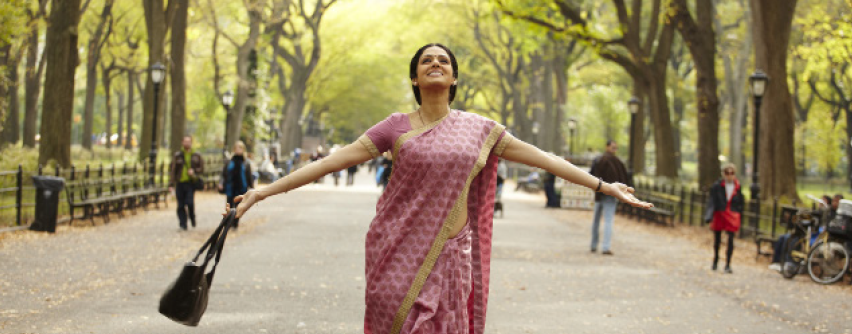Exploring the magic of Bollywood
The incomparable charm of Indian cinema never fails to deliver
The powerful Sridevi plays the role of Shashi in “English Vinglish”, displaying her confidence and strength when she arrives in Central Park in New York City.
December 1, 2022
In such a diverse country as India where there are so many different languages, cultures and walks of life, there are two binding factors that unite the country as a whole — Bollywood and Cricket. Bollywood, the Indian Cinema, is the one I prefer.
Bollywood is one of my favorite aspects of being Indian. It’s the aspect of Indian culture that makes me feel most connected to my roots and is the part of the culture that I enjoy sharing with the world the most. It’s probably annoying how much I talk about it, bring it up in conversation, reference its movies and randomly burst into singing Bollywood music.
Bollywood and Indian cinema is one of the most artistically rich fields of culture and media, and its contributions to pop culture will always be remembered. The most common films are masala films, which freely mix different genres including action, comedy, romance, family, friendship and drama along with dramatic and highly produced musical sequences.
The most common themes that Bollywood movies explore are cheesy romances, family, marriage and all the complications that those entail when discussed in an Indian context. However, my favorite Bollywood movies are those that are progressive, modern and explore the coming of age storyline or themes of friendship.
If I had to ask you to watch one Bollywood movie that is known worldwide but also entails the entire Bollywood movie experience, it would be “Dilwale Dulhania Le Jayenge”. Popularly known as DDLJ, this movie has been screening in one of the most iconic theaters in India, the Maratha Theatre in Mumbai, for 24 consecutive years. Its legacy is iconic. A huge chunk of the movie is shot in Switzerland, and to this date, there are tourist locations that tons of people visit just to see where the movie was shot. It contains all the classic elements a Bollywood movie should have, the drama in the family setting, the cheesy romance plot line, grand production in terms of the location, outfits and songs. The cast bursts into song, dance and fully coordinated sequences randomly at multiple times in the movie, giving you the entire experience.
Some of the critically acclaimed and globally renowned movies that Bollywood has contributed to pop culture — that also happen to be some of my favorites — are “English Vinglish”, “Yeh Jawaani Hai Deewani”, “Dil Dhadakne Do”, “3 Idiots” and “Wake Up Sid”.
“English Vinglish” follows the mission that screen legend Sridevi takes on the impactful mission of the awakening of a woman’s self-respect. Written and directed by Gauri Shinde, it follows the transformation of a meek and simple housewife, who isn’t respected by her community or family and speaks only Hindi, but decides to take on the mission of learning English through a four-week crash course in the bustling New York City. She turns herself into a confident citizen of the world who knows her self-worth and how she deserves to be treated. This movie’s message is important for Indian women who, like the main character, haven’t ever been presented with opportunities to discover who they really are as individuals.
“Wake Up Sid” is probably one of my favorite movies of all time. It is simple, comforting, refreshing and yet, so charming. At this time in my life, I see its hold over me more than ever. This coming of age movie is about the two sides of growing up. When standing on the cusp of adulthood and stepping out into the real world, there are two sides to the story. One is filled with young adults who are ready to take on the world, full of ambition and hope. On the contrary, there are those who are confused, lack direction and wish they could hold on to their childhood just a little bit longer.
Released in 2009, Ayan Mukherji’s directorial debut perfectly captures both of these sides of growing up. The story follows a young Siddharth Mehra, a rich and pampered brat from Mumbai, who has to face the fact that it is time to give up his childish antics and step up as an adult. It is at this point that he meets Aisha Banerjee, who moves to Mumbai to pursue her journalistic dreams.
I remember watching this movie when I was younger. I did not really understand the hype nor think it was irrelevant to my life. Now, the film charms me more with every rewatch. Even when I didn’t understand much, I remember fantasizing about Banerjee’s independence and her zest for life, — something I aspire to when I grow up. It was also transformative to see how the people around you can shape the person you become, like the influence Banerjee had on Mehra. This movie is about finding yourself, owning your unique personality boldly, choosing how you want to shape your life and rising up from instances that have brought you down. Thirteen years later, it is still relevant, nostalgic and hopeful and reminds us of the stories we write of our own lives.
I could go on forever talking about all of my favorite Bollywood movies, why they are all so important to pop culture and the immense impact they have had on their audiences, but I hope I have left you wanting to learn a little more about Bollywood and all of the great art it encompasses.














